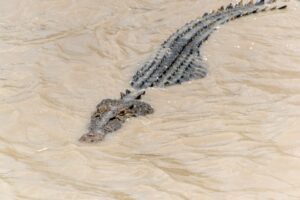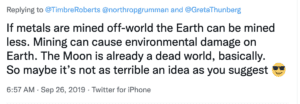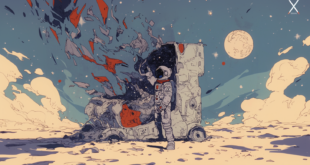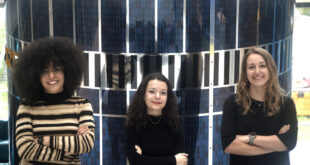by Alice Gorman

In 1985, the Australian ecofeminist philosopher Val Plumwood had an extraordinary experience. She was attacked by a crocodile while canoeing in Kakadu National Park in northern Australia. She fought the crocodile off three times and survived; but it had a profound effect on her philosophy. It brought home to her the existence of an external reality in which our perceptions are irrelevant.
As she described it, this near-death experience gave her “a glimpse ‘from the outside’ of the alien, incomprehensible world in which the narrative of self has ended”.
As a result, Plumwood came up with an approach to working in the world which she called co-participation (2006:130), in which the natural environment was not something to be mastered or used, but something that humans worked together with.
A key element of this approach is the concept of dependency. Plumwood argued that the cultural failure to understand human dependence on the life-giving systems of nature is a direct cause of non-sustainable use of natural resources (1993: 21). Not only this, but it also makes humans vulnerable; and it’s only at crisis points that that our dependence is foregrounded – often when it’s becoming almost too late to do anything about it. I have argued that this accurately describes the current situation in regards to space junk in Earth orbit (Gorman 2013).
Finally, Plumwood argued that “The inability or refusal to recognise the way non-humans contribute to or support our lives then encourages us to starve them of resources” (Plumwood 2009:4).
Before figuring out how to exploit the resources of the Moon, we need to study and understand the points of vulnerability for both humans AND the Moon itself.
So what happens when we apply the co-participation model to the Moon? It’s an often-stated ‘fact’ is that the Moon is dead, as if this is self-evident and indisputable (Gorman 2021). As Plumwood describes it, this is “The idea of nature as dead matter, to which some separate driver has to add life, organization, intelligence and design” (2009: 5). This, it seems to me, is very much how we view the Moon. Humans justify their exploitation of space by the old colonial rationale that conquest brings improvement: that they are injecting sentience into a formerly dead being. The Mars advocate Robert Zubrin is a major proponent of this position.

In the co-participation model, by contrast, we have to acknowledge that the Moon is no longer a passive body to which humans do things. It has its own existence and agency. The next step is to identify the dependencies and vulnerabilities. This might mean, for example, water, which is necessary to sustain human life and to grow the lunar economy that is the rationale for proposing more permanent settlement. It’s a resource, but it also makes us vulnerable, as we don’t fully understand the lunar water cycles. We don’t yet know how renewable it is. We could also say that night (the cause of death for more than one spacecraft as temperatures plummet) and dust (which clogs up machines and erodes seals) are lunar qualities which makes us vulnerable.
Then we might ask, what does the Moon need from us in order to survive? Another unstated assumption is that without living ecosystems, atmospheres, oceans and plate tectonics etc, that the Moon is less complex than Earth and hence less vulnerable to harm. In fact we don’t know any of these things. We don’t know what the Moon’s vulnerabilities are yet. We only know something of ours.
My final question is how this translates into action and I think this is a matter of priorities. Before figuring out how to exploit the resources of the Moon, we need to study and understand the points of vulnerability for both humans AND the Moon itself. The co-participation model does not close off the possibility of humans using lunar resources, but it does lead to a greater recognition of the Moon as an active agent, and a rebalancing of how resources are allocated: taking into account what the Moon needs to maintain its ecological integrity.
I will finish with a quote from the writer Ceridwen Dovey‘s poem “Moonrise” (2021) in which the Moon asserts its existence in a form independent of human fantasies.
I am made of much more disturbing stuff
Seas of death
Bays of lunacy
Craters of indifference to human time.
I think these lines would have resonated with Val Plumwood.
References
Gorman, A.C. 2021 Why did the Moon die? Paper presented to the Australian National University Deep Histories of Space seminar.
Gorman, A.C. 2020 Can the Moon be a person? As lunar mining looms, a change of perspective could protect Earth’s ancient companion. The Conversation, August 27.
Gorman, A.C. 2013 Final frontiers: space. The Conversation, April 10.
Plumwood, V., 1993 Feminism and the Mastery of Nature. London: Routledge
Plumwoood, V., 2009 Nature in active voice. Australian Humanities Review.
Plumwood, V., 2006 The Concept of a Cultural Landscape: Nature, Culture and Agency in the Land. Ethics and the Environment 11(2): 115-150

Alice Gorman is a space archaeologist and author of the award-winning book Dr Space Junk vs the Universe: Archaeology and the Future (MIT, 2019). She is an Associate Professor at Flinders University in Adelaide and co-director of the International Space Station Archaeological Project. In 2021, asteroid 551014 Gorman was named after her in recognition of her work.





